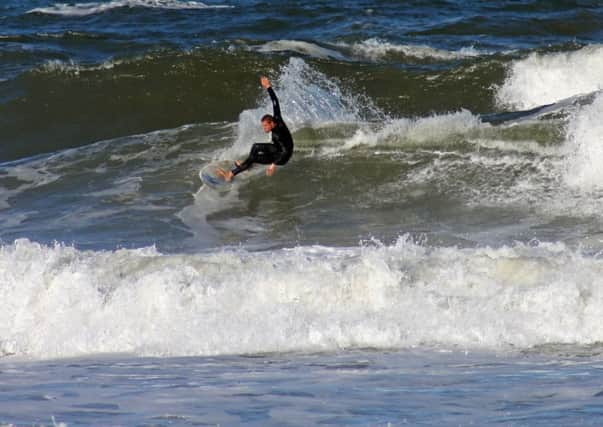Roger Cox: Surfing at Belhaven Bay near Dunbar


So why do I waste my time surfing there? If the whole point of going surfing is to find the best waves you can and ride them as well as you can, why would anyone in their right mind deliberately paddle out at a spot where the waves are known to be average? It’s not as if there’s a shortage of other options: there are plenty of much better places to go surfing in south-east Scotland, and I should know because I’ve surfed at most of them.
Perhaps it’s an age thing, but as the years roll by I find that “going surfing” is becoming less about the actual act of surfing itself and more about all the other things that feed into the experience. For a start, I like that it’s tricky to check the waves at Belhaven. Its charms – such as they are – reveal themselves slowly. Even though it’s a huge, open sweep of beach, it somehow manages to keep itself hidden from the road. Park your car at the south end of the bay, and – particularly at low tide – the waves will be so far away you’ll struggle to make out what they’re doing; park behind the dunes at the back of the beach, which I usually do because it means less of a hike to the water, and you won’t be able to see the waves at all. The only way to get an accurate idea of what the conditions are like is to walk through a first set of dunes, then out across a vast, tidal salt marsh, and then through another set of dunes. Only here do you get your first tantalising glimpses of lines of swell rolling in to the beach, and only once you’re through this second set of dunes can you really see what’s going on. Belhaven forces you to commit to it blindly, in other words. You go if you think the swell and wind and tide are going to align just-so, but you don’t find out for certain what kind of session you’re going to have until you’re standing there at the water’s edge, wetsuit on, board in hand. And if the waves are rubbish? Well, you’re here now – might as well get wet anyway.
Advertisement
Hide AdAdvertisement
Hide AdI used to hate the muddy squelch across the flats from the car park to the beach, and it’s true that on grey, misty days this no-man’s land can feel like the bleakest, loneliest place on Earth. Gradually, though, I’ve grown to love this deeply unglamorous patch of wilderness. If you keep your eyes peeled as you cross the marsh (which, incidentally, you should always try to do via the marked paths so as not to disturb the fragile, salt-resistant vegetation that thrives here) you can spy all kinds of interesting things nestled in the mud – fragments of sea shells, bits of sun-bleached driftwood, sometimes even tiny crab carcasses, washed several hundred metres inland by the last really high tide.
The best thing about the salt marsh, though, is the way it creates a physical barrier between the restrictions of everyday life and the limitless freedom of the sea. As you cross this liminal space, the background roar of the human world dies away, to be replaced (you hope) by the roar of the waves. Honolulu may have better surf than Belhaven, but when you’re sitting in the water between sets there and glance back towards the land you mostly see skyscrapers; here, in every direction, you mostly see sky.
It recently emerged that there are plans afoot to create an artificial wave pool in a disused quarry at Ratho near Edinburgh. Using so-called Wavegarden technology, if built this facility will be able to pump out perfectly-peeling head-high waves, 24/7, for as long as people want to surf them. I can’t claim not to be excited by the prospect of limitless perfect waves – what better way to improve your technique than in a controlled environment unaffected by wind or tide, where the waves break in the same place over and over again? And yet… given the choice between guaranteed perfect waves at Ratho and the vague possibility of half-decent waves at Belhaven, I’d go for Belhaven every time. Sure, I’d spend less time surfing and more time chasing peaks up and down the beach as they shift with the tide, but the thrill and complexity of the chase is something we’ll never be able to replicate. Plus, every now and then the waves are actually OK.